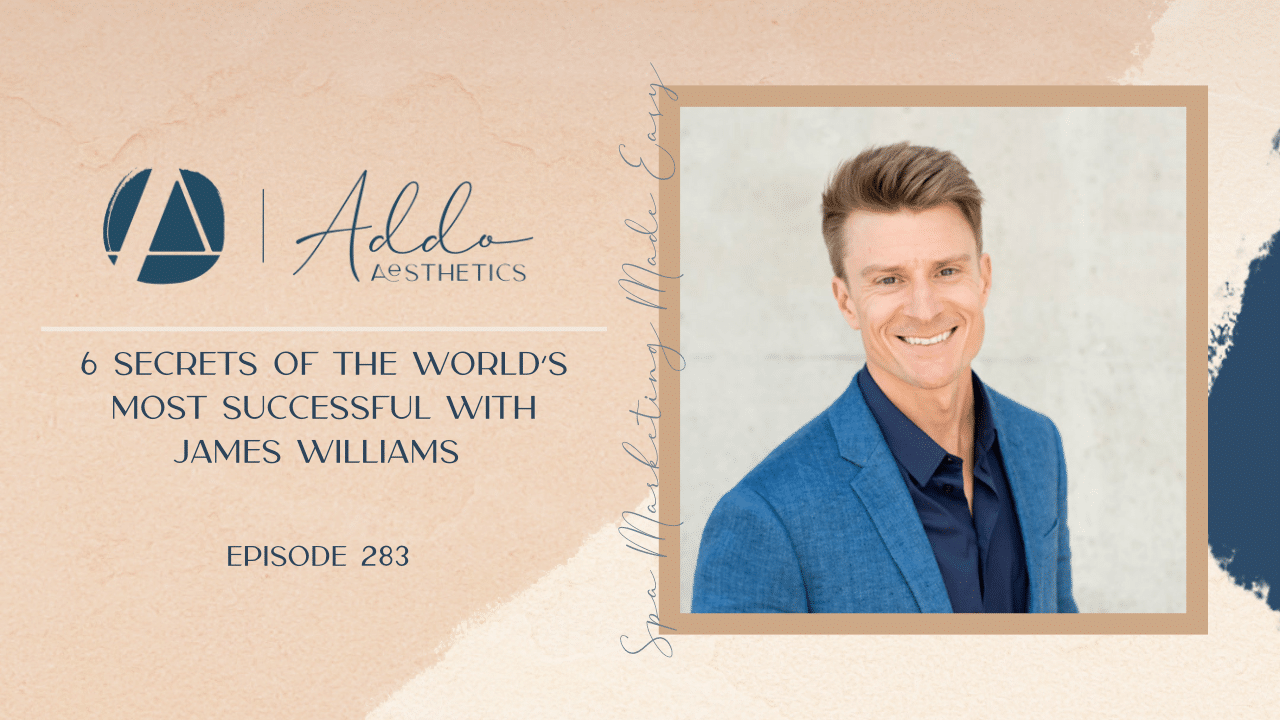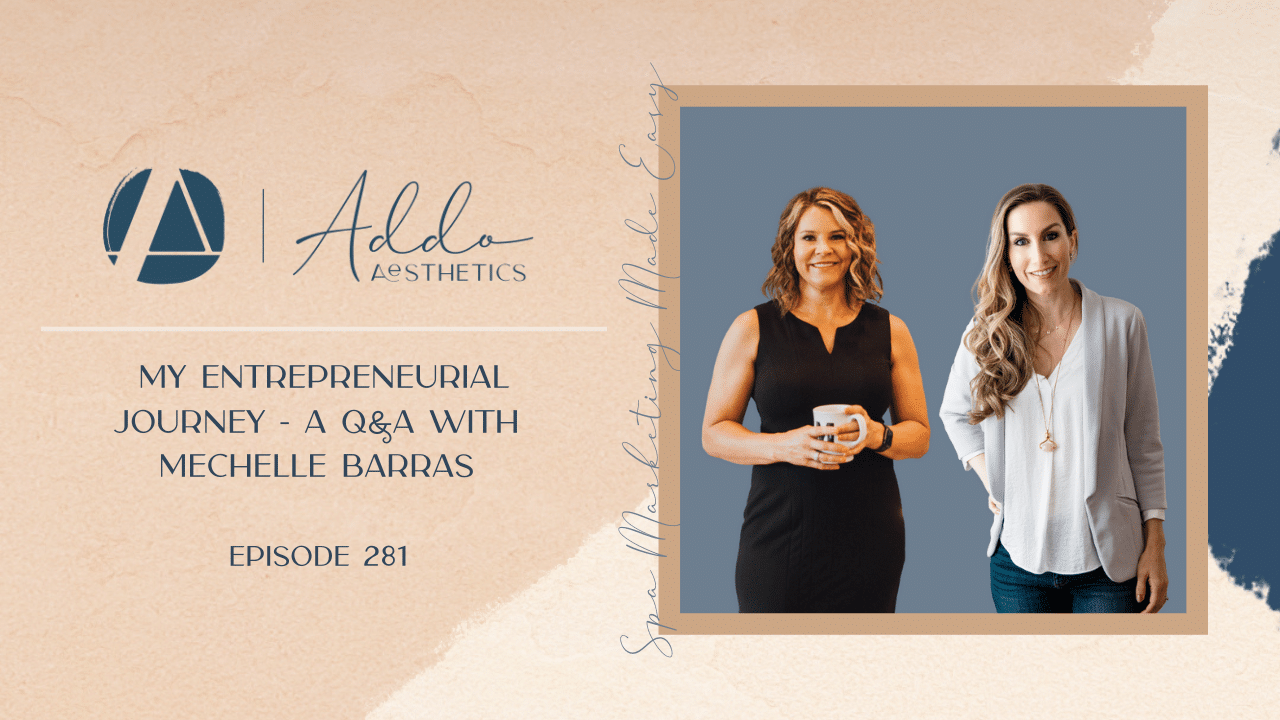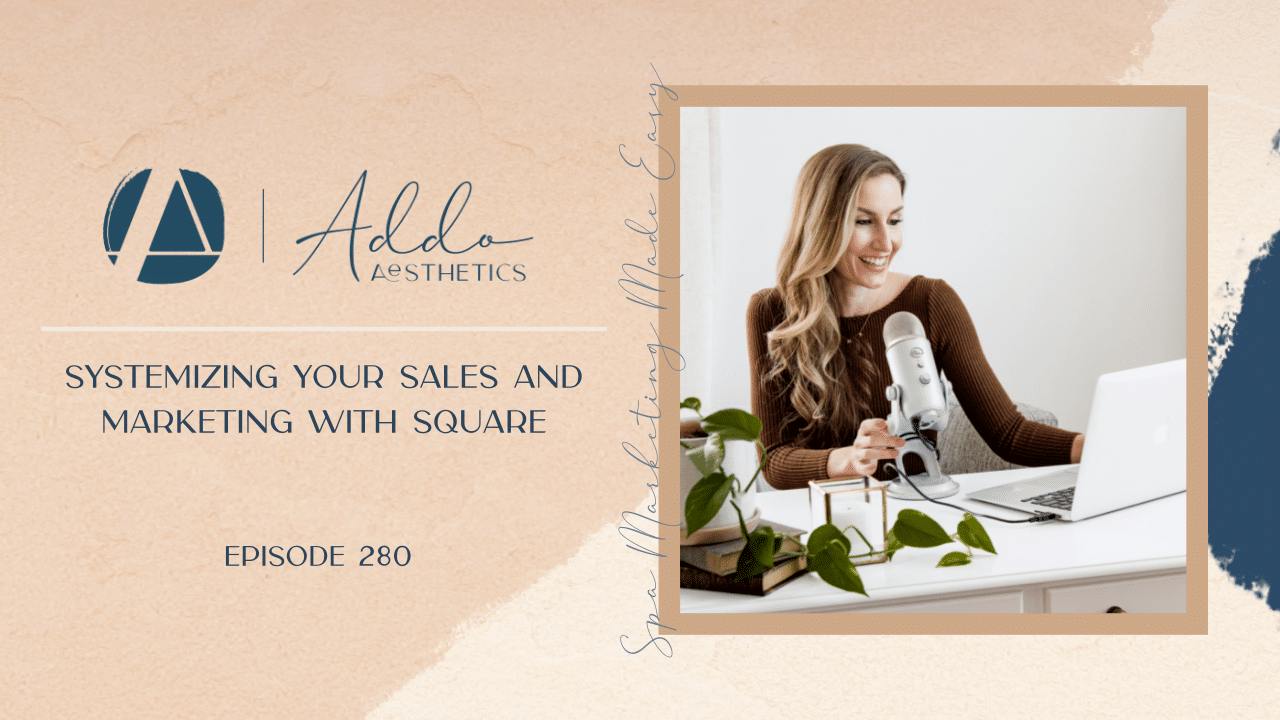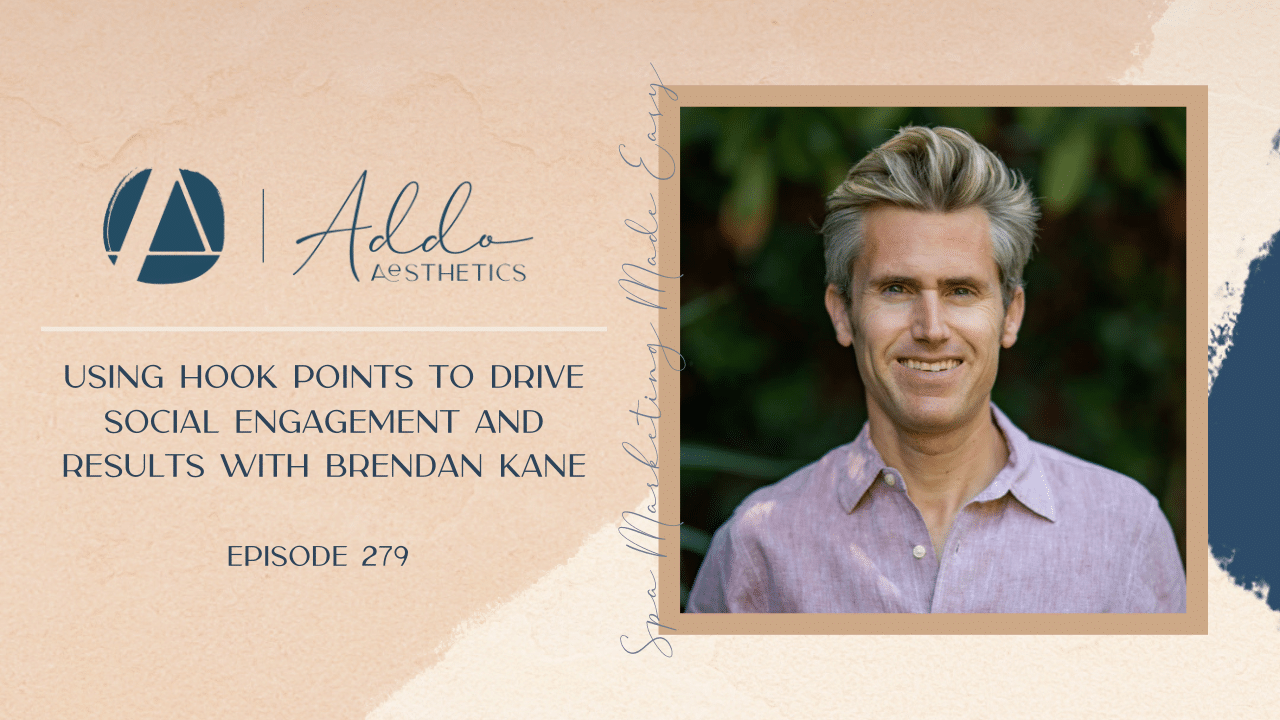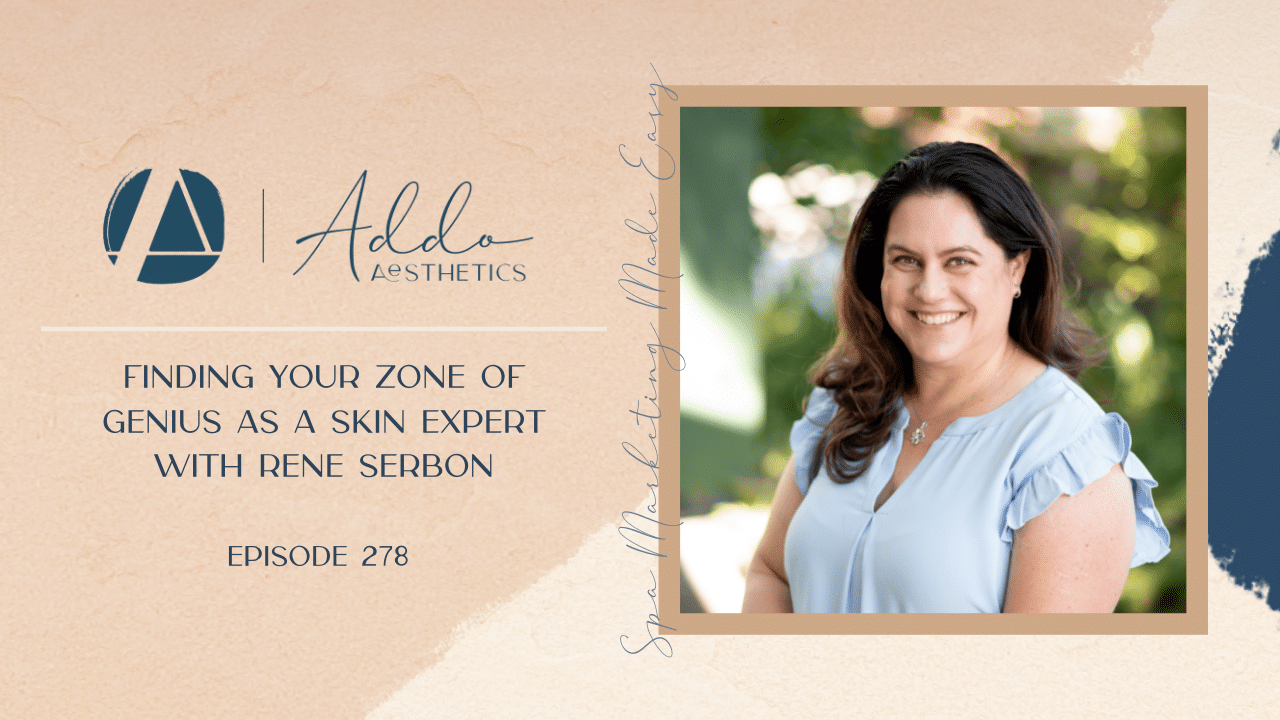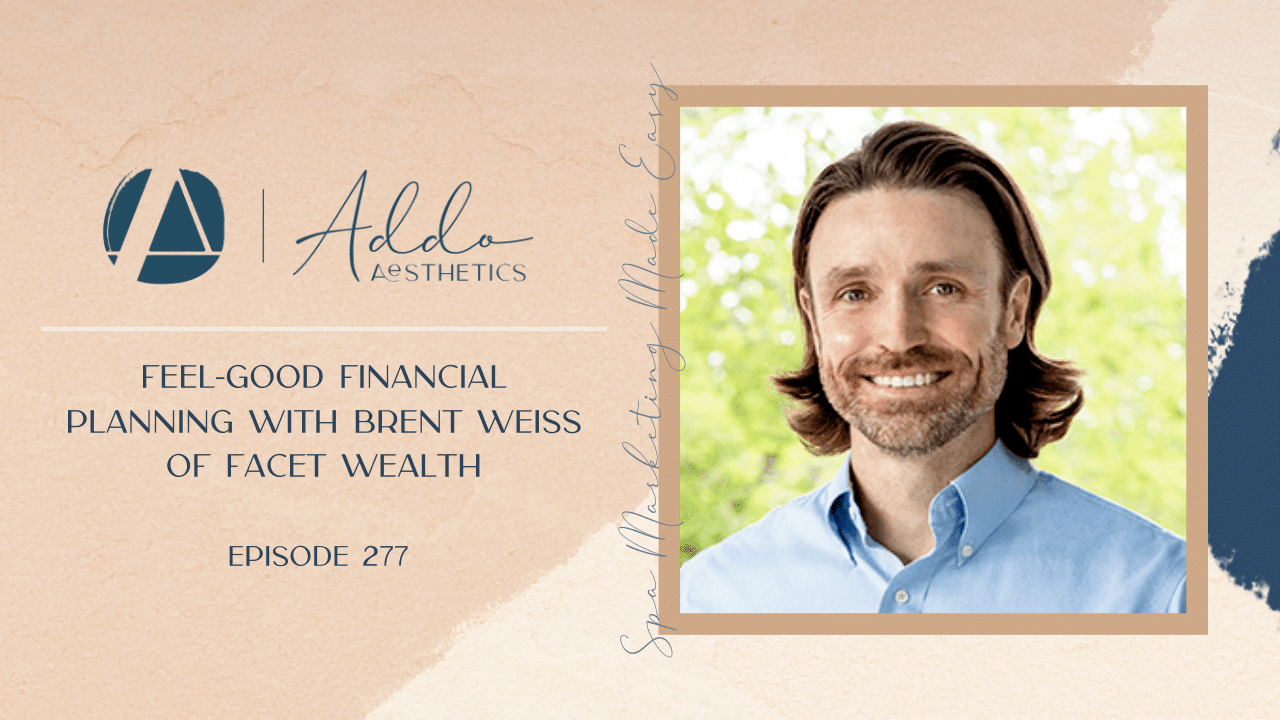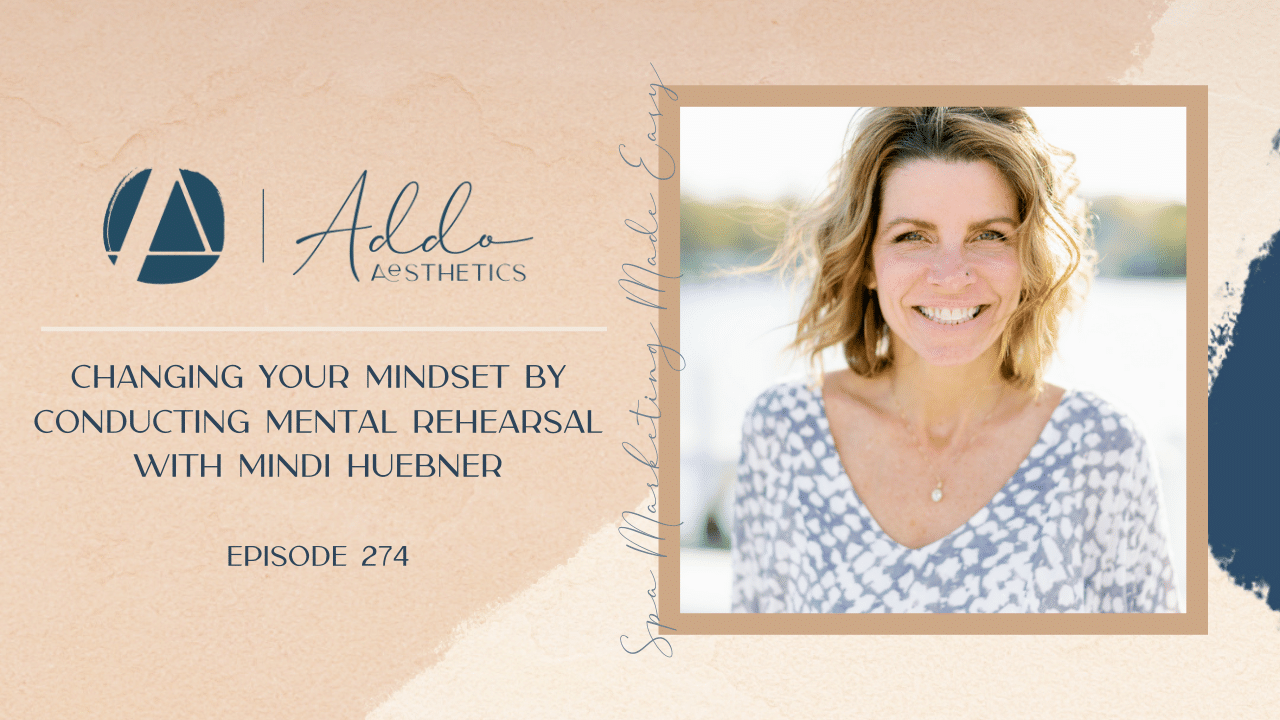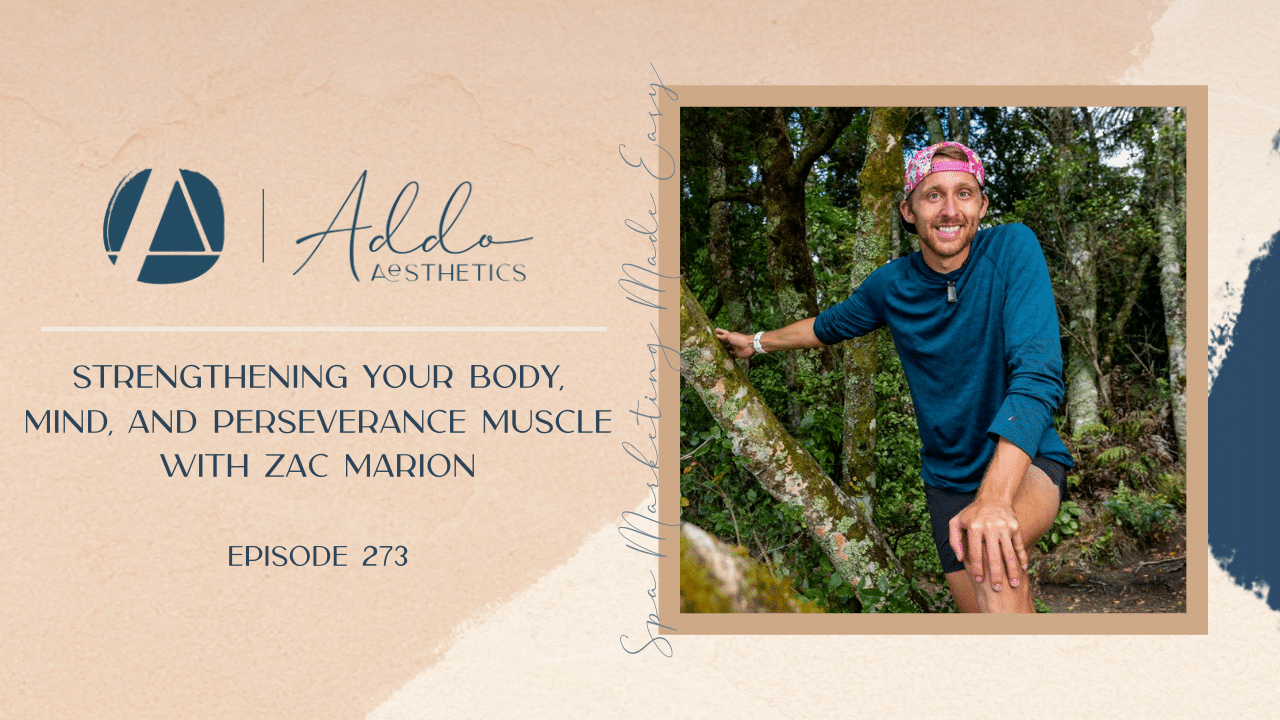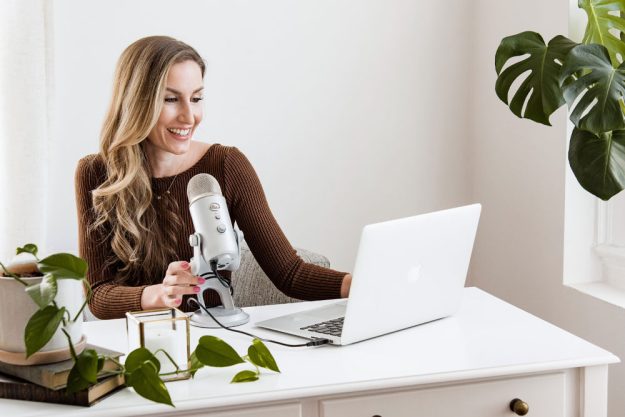
Catch the Latest Episode of Spa Marketing Made Easy
As a spa professional, one of the biggest keys to creating a life you love is getting more clients in the door. Easier said than done, right? With the Spa Marketing Made Easy Podcast, you can get all the tools you need. Join host Daniela Woerner, licensed esthetician, to get simple, proven strategies for marketing your spa business.
To start a business and become an entrepreneur means you are a high achiever, but being a high achiever – one with big goals, dreams, and vision – doesn’t necessarily equate to being a high performer.
However, as you might have guessed, being successful in achieving your goals and doing so in a way that leaves you fulfilled, energized, and purposeful, does require high performance.
In this episode, which was a coaching call inside of the Growth Factor Framework program, my guest, James Williams shared a fantastic presentation based on real-world data on the world’s most successful people, and what we can glean from them, and I knew I had to share it with everyone in the Spa Marketing Made Easy community.
James is a Performance Breakthrough Coach, founder of The Growth Edge, and speaker who is passionate about focusing on creating outer world impact through inner world mastery.
His passion for mastering physical, mental and emotional performance in pursuit of his own life goals is only matched by his dedication to supporting his clients’ belief that anything is possible and available for them.
As you listen in, I really want you to be honest with yourself on the answers to some of the questions he raises as he works through the six secrets, and also know that you are 100 percent capable of being a high performer if you’re not quite meeting the benchmarks needed to perform at your highest level.
The hardest work we have to do as entrepreneurs is directly between the ears, and you, my dear listener, are capable of anything you set your mind to, I truly believe that, but you have to believe it for yourself.
In this episode, you’ll learn:
- What does “high performance” actually mean and what does it look and feel like
- How high performers show up in their life and work and the six key secrets that the world’s most successful high performers have in common
- The key life factors that high performers have at heightened levels and are able to sustain
- The vital importance of self-care, sleep, knowing your mission, and more; plus, what it actually means to be selfish in the way you carry out your daily life (it’s not what you think)
References Mentioned in Episode #283: 6 Secrets of the World’s Most Successful with James Williams
- To learn more about James and his work through his company, The Growth Edge
- Connect with James on Instagram @jamesrswilliams or on LinkedIn
- To keep the conversation going, ask questions, and connect with other like-minded aestheticians building thriving careers, click here to join the free Spa Marketing Made Easy Podcast community.
Episode Transcript
Many spa owners get into their path of entrepreneurship because they love the work, the people, the transformations they help their clients make.
But as many spa owners discover, being a provider in the treatment room isn’t something many of us aim to do forever.
If you’ve been thinking about your next stage of spa ownership and crafting an exit strategy that keeps your spa successful but allows you to remove yourself from the treatment room, I’ve got a treat for you in this episode of Spa Marketing Made Easy.
In this episode, I’m talking with my long-time client and dear friend, Andrea Klein, who is now on the “work optional” path of entrepreneurship.
This is a woman who was operating as a solo aesthetician just a few years ago and has now built her spa to 7-figures and is branching into the world of ecommerce and non-profit work.
If you don’t know Andrea yet, she is a licensed aesthetician, multiple business owner and self-proclaimed women’s activist. She started her career by going to beauty school at age 34 and in less than 9 years she’s built a 7-figure day spa that she was able to retire from so she could focus on her life’s purpose, the Liberté Foundation for Women.
Andrea now travels the world documenting women’s stories of freedom and entrepreneurship, and through her nonprofit, she is able to share the gift of freedom through grant giving to female small business owners around the world.
Tune in as we talk about her journey to this “work optional” path of entrepreneurship and what she’s working on today to create impact and legacy, plus how you can receive some of that impact as an entrepreneur in the beauty industry.
In this episode, we discuss:
- Some of the mindset shifts Andrea has to go through as she removed herself from her spa and relied fully on her team
- What things Andrea had to get clear on in order to pave the path forward for her spa to be able to operate in the day-to-day without her
- The importance of acknowledging and overcoming limiting beliefs and a discussion around feminine energy and embracing our natural gifts and inclinations
- How Andrea is scaling for impact through her work with her skincare company and her 501-c3 non-profit, the Liberté Foundation
- More insight on how AddoAesthetics is participating in the Liberté Foundation’s mission through grants for women in the spa and beauty industry
References Mentioned in Episode #282: Navigating the Work Optional Path of Entrepreneurship with Andrea Klein
- Learn more about Liberté Skincare and the Liberté Foundation for Women
- Apply for one of the Liberté Foundation grants for women entrepreneurs in the beauty industry
- Listen to my previous episode with Andrea, “Episode #244: From Solo Aesthetician to Retired Spa Owner in 18 Months with Andrea Klein”
- Book Recommendation: Pussy: A Reclamation by Mama Gena
- Book Recommendation: Predictable Success: Getting Your Organization on the Growth Track–and Keeping it There by Les McKeown
- To keep the conversation going, ask questions, and connect with other like-minded aestheticians building thriving careers, click here to join the free Spa Marketing Made Easy Podcast community.
Episode Transcript
In this week’s episode, we’re flipping the mic as I act as guest on my dear friend and client Mechelle Barras’ podcast, Mindset Great!
If you’ve been a listener of Spa Marketing Made Easy for awhile, you’ve likely heard Mechelle’s story (and if not, be sure to go back and give it a listen – link below!), and I was honored when she asked to interview me on her podcast.
And since we have so many new listeners who may not be as familiar with my entrepreneurial story, I hope this interview serves as a good introduction, and that you can walk away with a few nuggets of wisdom.
Because, as you’ll hear, one of my favorite business mantras is that “a rising tide lifts all boats,” and since I’ve certainly picked up countless lessons over the last eight years, I’m happy to be able to share them with you, my fellow CEO!
In this episode, we discuss:
- How I started my entrepreneurial journey and why I consider myself an “accidental entrepreneur”
- What support systems I’ve had and continue to put in place to be able to accomplish my personal and professional goals
- My approach to planning within my business and how my personal life serves as the driving force behind all my decisions
- Why I’m partnering with the Liberté Foundation to provide grants to women in the spa and beauty industry
References Mentioned in Episode #281: My Entrepreneurial Journey – a Q&A with Mechelle Barras
- Subscribe to the Mindset Great podcast and learn more about Mechelle and her work on her website and connect with her via Instagram @Mechelle_Barras
- Listen to my episode with Mechelle, “Episode 256: Mapping and Fulfilling Your Goals for Greatness with Mechelle Barras”
- Learn more about the Liberté Foundation grants for women in the beauty industry by clicking here
- To keep the conversation going, ask questions, and connect with other like-minded aestheticians building thriving careers, click here to join the free Spa Marketing Made Easy Podcast community.
Episode Transcript
Anyone who has done their thorough research on technology solutions for their spa knows there is no shortage of tools to choose from.
The good news is that you have a plethora of choices, the bad news is that you have to sift through them all!
In an effort to help you with the sifting, in this episode of Spa Marketing Made Easy, I’m chatting with Willem, who is Head of Appointments and Messengers at Square.
Square helps businesses across the globe more easily run and grow their businesses with its integrated ecosystem of commerce solutions, and Square Appointments provides an all-in-one POS booking solution specifically designed for the beauty and wellness space.
In this episode, he’s answering all my questions on what Square is capable of so you can get the real 4-1-1 if it’s the best software solution for you and your business.
In this episode, we discuss:
- What Square brings to the table as an all-in-one software solution for spas and salons
- The key services that Square provides that are critical for your brick and mortar success
- Square’s capabilities for integrating with your digital marketing and online storefront
- Square’s varius tech functionalities around advanced marketing techniques, selling capabilities, customer relationship management, and more
References Mentioned in Episode #280: Systemizing Your Sales and Marketing with Square
- Learn more about Square by clicking here
- Follow Square on Instagram
- To keep the conversation going, ask questions, and connect with other like-minded aestheticians building thriving careers, click here to join the free Spa Marketing Made Easy Podcast community.
Episode Transcript
Between new platforms showing up on the scene, constant algorithm shifts, and only so many hours in the day, cracking the code on social media can feel like playing a game where the rules change every time you get to a new level.
While some of those things have truth, the good news is that the key to social media success and creating content your ideal clients and customers actually want to engage with is actually based on a single rule: create great hook points.
Here to break down this concept with me on this episode of Spa Marketing Made Easy is Brendan Kane, an outside-the-box thinker, speaker and author who empowers brands to scale by helping them stand out and beat competition in crowded and oversaturated markets.
Brendan is the author of the international best-selling book One Million Followers and the newly released ”Hook Point: How To Stand Out In A 3 Second World,” as well as the founder and CEO of the Hook Point agency.
Brendan has worked with hundreds of individuals and brands including MTV, Taylor Swift, and Rhianna.
Tune in and take note, this is an episode chock-full of tips you’ll want to put into action today!
In this episode, we discuss:
- Brendan’s backstory on how he broke into social media and how that journey brought him to building a following of 1 million people
- Why it’s critical in today’s media landscape to be able to grab attention effectively
- The true purpose of the algorithm and why we it’s not the number one thing we should be concerned about with our social media marketing strategy
- The 3 key factors that define a successful hook point and how we can start creating them in our marketing and social media content
References Mentioned in Episode #279: Using Hook Points to Drive Social Engagement and Results with Brendan Kane
- Get Brendan’s latest book, “Hook Point: How To Stand Out In A 3 Second World”
- Learn more about Brendan’s work via his website and connect with him on Instagram @brendankane
- Get Brendan’s other book, “One Million Followers: How I Built a Massive Social Following in 30 Days”
- To keep the conversation going, ask questions, and connect with other like-minded aestheticians building thriving careers, click here to join the free Spa Marketing Made Easy Podcast community.
Join the Aesthetic Marketing Seminar, the premiere spa marketing event of the year, on May 16 + 17, 2022 to learn the most relevant strategies and systems that today’s spa owners need to shift from biz chaos to Spa CEO.
[ Learn More + Get Your Ticket to the AMS ]
Episode Transcript
One of the business mantras and beliefs that I hold deep down to my core and that I’ve practiced before even officially starting my own business is that community is greater than competition.
I truly believe that this mindset is critical for finding success, especially as more and more people venture into entrepreneurship, especially within the aesthetics industry.
Someone who identifies with and speaks to that notion beautifully is my guest on this episode of Spa Marketing Made Easy, René Serbon.
René is an international skin expert who started her education focusing on business studies in marketing and then moved to aesthetics, and is now a sought-after skincare educator and serves on the board of education for the International Association For Applied Corneotherapy.
With a host of aesthetic certifications, accolades, and subject matters in which she is an expert, René is truly a full-scope professional, but as we discuss in this episode, becoming a master of your trade requires more focus versus collecting more skillsets.
In this episode, you’ll hear:
- René journey from being a professional waxer to shifting into skin-focused expertise and branching into education
- What Corneotherapy is and how it differs from other skincare practices, techniques, and philosophies
- Why it’s critical to pinpoint your niche and how to begin discovering what yours might be
- How to make your specific processes, for skincare treatments, consultations, and business scalable and sustainable
- Why selling is a service and a mindset reframe around what it means to be a skincare expert who gets paid what they’re worth
References Mentioned in Episode #278: Finding Your Zone of Genius as a Skin Expert with René Serbon
- Connect with René via her website, on Instagram, Facebook, and LinkedIn
- Join Rene’s Skin Care Professionals Strategy Group on Facebook
- Learn more about The International Association for Applied Corneotherapy (I.A.C.) at corneotherapy.org
- To keep the conversation going, ask questions, and connect with other like-minded aestheticians building thriving careers, click here to join the free Spa Marketing Made Easy Podcast community.
Join the Aesthetic Marketing Seminar, the premiere spa marketing event of the year, on May 16 + 17, 2022 to learn the most relevant strategies and systems that today’s spa owners need to shift from biz chaos to Spa CEO.
[ Learn More + Get Your Ticket to the AMS ]
Episode Transcript
You know how the saying goes, “never say never.”
Well, that may apply 99% of the time, but this is the 1% time where you want to throw that adage out the window because whether you’re working to hit that first 6-figure year in your spa, or you’re climbing the mountain to a million, there is never a better time to get your financial plans in order than right now.
Even if you’re listening to this episode a week, 2 months, or 2 years after its original release, everything that’s shared is still timely, timeless, and applicable.
And as my guest shares, even if you think you’re too late in the game when it comes to financial planning, there’s never an age too old to start (there’s that ‘never’ word again).
Here to discuss the timeless topic of financial planning with me in this episode of Spa Marketing Made Easy is Brent Weiss, the co-founder and Chief Evangelist of Facet Wealth.
{ If you’re wondering what in the world a “Chief Evangelist” is, I had the same question! }
In a nutshell, Brent’s role is to be the “keeper, speaker, and champion” of the Facet Wealth cause, which is to give everyone clarity and confidence by building a financial plan based on personalized advice for all the financial decisions that impact your life.
Now, all you loyal listeners know I’m a nerd for money conversations, but Brent truly makes the topic of financial planning a feel-good experience, and as a Facet Wealth client myself, I can truly attest to the fantastic experience and advising they provide.
I know this isn’t the “fun” stuff in business, but I can promise that having a financial plan feels a whole lot better than flying by the seat of your pants.
So pull up an earbud, I can’t wait for you to tune in.
In this episode, we discuss:
- Why having a financial plan and financial advisor is so important, especially as a business owner, and why it’s critical that you align your financial plan with your life and business goals
- How traditional financial planning services work, and how Facet Wealth is working to do things differently
- Brent’s top insights on what to look for when finding the right-fit financial advisor for you and what key indicators to look out for when interviewing your potential advisor
- Why it’s never too late to craft a financial plan and why you need a “To Be” list versus a “To Do” list when it comes to your financial planning vision
References Mentioned in Episode #277: Feel-Good Financial Planning with Brent Weiss of Facet Wealth
- Learn more about Facet Wealth on their website
- Connect with Facet Wealth on Instagram, TikTok and LinkedIn
- Connect with Brent via his email at brent(at)facetwealth.com or on Instagram at @thebrentweiss
- To keep the conversation going, ask questions, and connect with other like-minded aestheticians building thriving careers, click here to join the free Spa Marketing Made Easy Podcast community.
Join the Aesthetic Marketing Seminar, the premiere spa marketing event of the year, on May 16 + 17, 2022 to learn the most relevant strategies and systems that today’s spa owners need to shift from biz chaos to Spa CEO.
[ Learn More + Get Your Ticket to the AMS ]
Episode Transcript
A system for your systems?
I know, it sounds like systems inception, and maybe it is, but it’s also the critical key that unlocks the ability to truly have a systems-based business.
Because here’s the thing, you can have systems documented here and there and you could even have a decent number of SOPs being utilized inside your spa…
But what happens when a piece of the process changes?
Or someone new gets hired?
Or a new system needs to be created?
In this episode, we’re diving into the process of crafting a system for your systems.
By having an overarching system for ensuring and overseeing how to create, develop, and nurture all the other systems in your spa, you’re providing the ultimate structure for continual systems-based success for not only you as the Spa CEO, but also your existing and future team members as well as your business.
If you want to get (or keep) operations humming along and maintaining your business’ progress as a well-oiled machine, this episode isn’t to be missed!
In this episode, you’ll learn:
- What it means to have a system for creating your systems and why this is a critical piece to running a true systems-based business
- The mindset shift you need around systems to make this process work for you in the long-run and the quarterly practice you need to put on the calendar to make your systems goals a reality
- A breakdown of how we organize, update, and manage our systems so that they evolve alongside the evolution of the business and help us to continue to grow and operate efficiently
- My top tips for keeping up with and evaluating your systems as the Spa CEO
References Mentioned in Episode #276: Why You Need a System for Systems Creation
- Use the Loom screen-recording tool to help take the heavy lifting out of systems and SOP creation
- To receive a copy of our Spa CEO Quarterly Review Worksheet, comment “Q1” under this video in the Spa Marketing Made Easy Community or send us a DM with “Q1” in the message on Facebook or on Instagram
- Learn more about the Growth Factor Framework program
- To keep the conversation going, ask questions, and connect with other like-minded aestheticians building thriving careers, click here to join the free Spa Marketing Made Easy Podcast community.
Join the Aesthetic Marketing Seminar, the premiere spa marketing event of the year, on May 16 + 17, 2022 to learn the most relevant strategies and systems that today’s spa owners need to shift from biz chaos to Spa CEO.
[ Learn More + Get Your Ticket to the AMS ]
Episode Transcript
Have you ever dreamed about being an aesthetic expert who’s a household name?
Or the owner of a spa that the stars frequent?
Maybe you want to be industry-known as a thought leader and educator?
No matter what level of stardom you envision for yourself, the first step (and maybe the peak you aspire to) is becoming a micro-celebrity.
Joining me in this episode to explain what being a micro-celebrity means, what it entails, and how to become one is Ron Reich.
Ron is a marketing and launch strategist for mission-driven experts and coaches who want to scale from 6 to 7 figures and beyond. Together we’re talking all about how to up-level your authority to skyrocket your industry influence.
Even if you have no intention of becoming a “celebrity aesthetician,” I want you to go into this episode with an open mind about what it means to be a “celebrity,” especially on the local level or within the inner-industry space (not necessarily a celebrity on the customer-facing side).
This is all about influence and brand-building, and as an aesthetic expert and Spa CEO, influence is key no matter what your vision for future growth.
And like Ron mentions, “We don’t need to be a celebrity to a million people or even a thousand people to be influential.”
In this episode, you’ll learn:
- The benefits of positioning yourself as an industry influencer
- What it means to be a “micro-celebrity” and what steps you need to take to become one
- Why getting clear on your niche is crucial to building your authority
- Ron’s top tips on getting clear on your values and creating a brand-aligned atmosphere
References Mentioned in Episode #275: Becoming a Micro-Celebrity for Ultimate Industry Authority
- Connect with Ron and learn more about his work on his website
- Connect with Ron in Instagram and Facebook
- Get your ticket for the Virtual Aesthetic Marketing Seminar (May 16 – 17, 2022) by clicking here.
- To keep the conversation going, ask questions, and connect with other like-minded aestheticians building thriving careers, click here to join the free Spa Marketing Made Easy Podcast community.
Join the Aesthetic Marketing Seminar, the premiere spa marketing event of the year, on May 16 + 17, 2022 to learn the most relevant strategies and systems that today’s spa owners need to shift from biz chaos to Spa CEO.
[ Learn More + Get Your Ticket to the AMS ]
Episode Transcript
In theory, I think we all understand that a positive mindset and a good attitude will take you far in life no matter what you do personally or professionally.
But truly unlocking your highest potential?
Well, that takes more than just positive vibes.
As my guest in this episode of Spa Marketing Made Easy explains, taking intentional and aligned action to rewire our brain (a process she calls Mental Rehearsal) is the unlock that brings us beyond more surface-level mindset work and into true personal evolution and development.
Joining me in this episode is Mindi Huebner, an Intuitive Mindset Mastery Coach, NLP practitioner, a certified Health, and Life and Success coach and Clinical Hypnotherapist.
Mindi’s number one mission is helping women to reveal and release their limiting beliefs and embrace the confident, wildly successful humans they were made to be.
Listen in on this episode where we delve into Mindi’s tips around rewiring your brain as the key to unlocking your magic so that you can create a soul-aligned business and extraordinary life.
In this episode, we discuss:
- The keys to moving past limiting beliefs and why we have them
- Mindi’s practice of “Mental Rehearsal” and how it works to begin unlocking your mindset that’s framed with positivity and for abundance
- Steps for how to begin conducting your own mental rehearsal
- Mindi’s top tips for setting yourself up for mindset work success and taking any shame out of the equation
References Mentioned in Episode #274: Changing Your Mindset by Conducting Mental Rehearsal with Mindi Huebner
- Connect with Mindi and learn more about her work on her website
- Get Mindi’s free “Rewire Your Brain” guided meditation and mental rehearsal resource here
- Follow Mindi on Facebook, Instagram, and LinkedIn
- Get your ticket for the Virtual Aesthetic Marketing Seminar (May 16 – 17, 2022) by clicking here.
- To keep the conversation going, ask questions, and connect with other like-minded aestheticians building thriving careers, click here to join the free Spa Marketing Made Easy Podcast community.
Join the Aesthetic Marketing Seminar, the premiere spa marketing event of the year, on May 16 + 17, 2022 to learn the most relevant strategies and systems that today’s spa owners need to shift from biz chaos to Spa CEO.
[ Learn More + Get Your Ticket to the AMS ]
Episode Transcript
As the last couple of years have unfolded, I’m sure you can attest to the fact that exhibiting resilience and perseverance feels like a mental and emotional workout.
It takes a lot of effort and stamina, but as you continue to do it and do it more often, the easier it becomes.
Working out your body is exactly the same, and as my guest on this episode shares, there’s a real, scientific link (more than one) between the mind-body connection, and choosing to harness this as a human and as an entrepreneur is one of the most tried-and-true ways to reach your definition of success.
In this episode of Spa Marketing Made Easy, I’m joined by Zac Marion, a professional runner whose journey began unconventionally with a simple desire to lose weight.
Well, a 100-lb weight loss eventually led to competing in 100-mile ultramarathon races around the world and a career change from business to completing a doctorate degree in physical therapy.
As my go-to iFit trainer, Zac has personally led me through great physical feats that have also helped me to strengthen my mental fortitude, which in turn helps my business and I knew I had to get him on the mic to share his expert knowledge and perspective.
Tune into this episode to hear:
- Zac’s personal health journey and how he made the decision to choose a new path rather than the one that was automatically assigned to him
- How your “Why” applies to all facets of life, including your personal health journey and how that then intertwines with your business vision
- The science behind movement and mindset, and the impact it has on your mental fortitude and perseverance
- Why investing in your health is the ultimate investment, and how you can begin to reshift your perspective to make it a priority
References Mentioned in Episode #273: Strengthening Your Body, Mind, and Perseverance Muscle with Zac Marion
- Learn more about Zac’s work through Rising Mountains Coaching
- Connect with Zac on Instagram at @zac_marion
- To keep the conversation going, ask questions, and connect with other like-minded aestheticians building thriving careers, click here to join the free Spa Marketing Made Easy Podcast community.
Episode Transcript
We all know that revenue is critical to running a successful, profitable, and sustainable business, but what’s often overlooked is that some revenue has a higher value to your business’ bottom line than others.
Yes, a dollar is still a dollar and that won’t change, but what *can* shift is the flow of cash in your business based on the various revenue streams you’ve built.
And when it comes to the bottom line (and how your revenue makes its way there), the key to success for your spa lies in diversification.
That’s why in this episode of Spa Marketing Made Easy, I’m covering the three key types of revenue you’ll want to have working within your spa and how they work with and flow together to give your business the strongest financial ground to stand (and grow) on.
In this episode, you’ll learn:
- Why having diversified revenue is important for your business’ financial cash flow
- The ultimate goal of having multiple revenue streams and what it can help you achieve in your business growth journey
- A breakdown of the three types of revenue streams every spa needs
- How to weave together and leverage all three to give your business the best financial ground to stand on
References Mentioned in Episode #272: 3 Types of Revenue Every Spa Needs
- Learn more about Growth Factor Framework
- Learn more and enter for a $10,000 Grants for Female Entrepreneurs in the Beauty Industry
- To watch more trainings like this and to keep the conversation going, as well as connect with other like-minded aestheticians building thriving careers, click here to join the free Spa Marketing Made Easy Podcast community.
Episode Transcript
